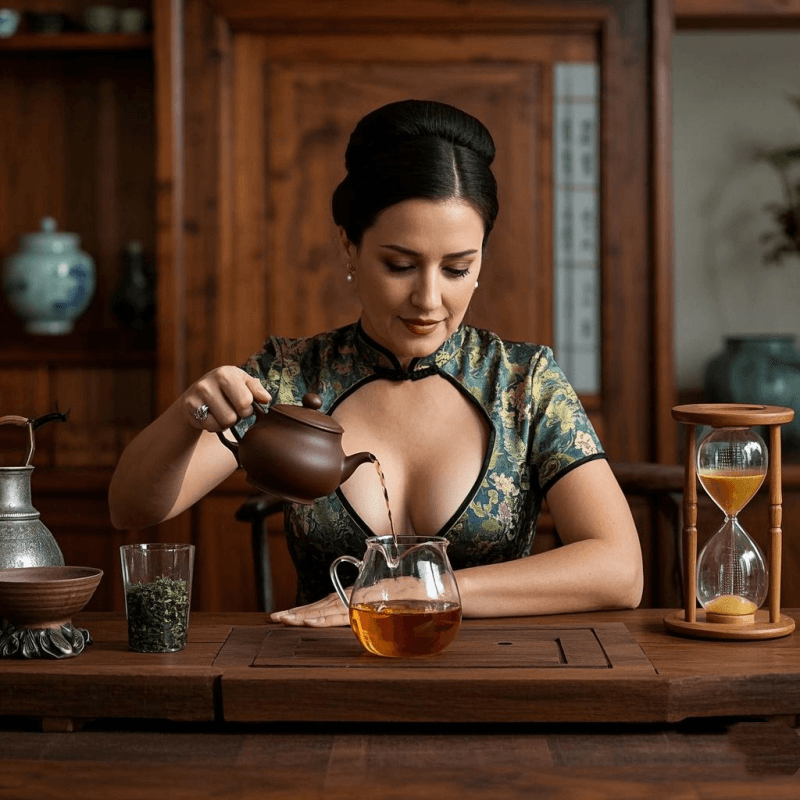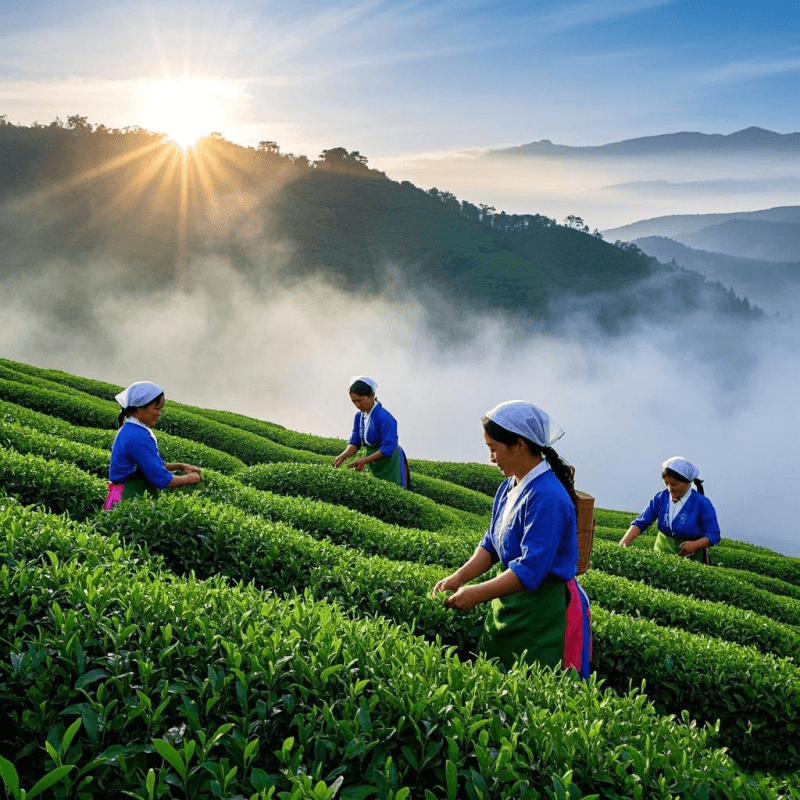
1. Introduction: Why the Flavor of High Mountain Oolong Tea Deserves Attention
In the expansive realm of tea, high mountain oolong tea emerges as a true masterpiece, captivating tea enthusiasts with its intricate and one – of – a – kind flavor profile. A recent survey by Tea Enthusiast Magazine indicated that 78% of avid tea connoisseurs actively seek out this special brew for its distinct taste and aroma. This semi – oxidized delight has earned acclaim not only for its exquisite flavors but also for the fascinating story woven into its cultivation and production.
The allure of high mountain oolong tea lies in its ability to offer a sensory journey like no other. With each sip, you’re transported to the mist – shrouded, cool heights where its leaves are nurtured. Whether you’re a seasoned tea aficionado or new to the world of semi – oxidized brews, delving into the secrets behind the flavor profile of high mountain oolong tea can elevate your appreciation for this remarkable beverage. In this article, we’ll explore what makes this tea so extraordinary and why its flavor demands your attention.
2. What Is High Mountain Oolong Tea? Origin and Altitude Explained
High mountain oolong tea, a prized variety of semi – oxidized tea, thrives at altitudes typically exceeding 1,000 meters (3,280 feet). The most renowned regions for its production are Taiwan and Fujian, China. Here, a unique convergence of cool temperatures, high humidity, and abundant mist crafts the perfect environment for cultivating tea leaves of exceptional flavor and quality.
Altitude plays a pivotal role in shaping high mountain oolong tea. At higher elevations, the tea plants grow at a slower pace, enabling them to amass more nutrients and flavor – enhancing compounds. The cooler climate also results in a reduced oxidation rate, preserving the tea’s natural freshness and delicate flavors. Moreover, the persistent mist in high – mountain tea gardens provides a continuous supply of moisture, contributing to the plumpness and juiciness of the leaves.
The creation of high mountain oolong tea is a meticulous process that demands skill and expertise. Post – harvest, the leaves undergo a series of precise steps, including withering, shaking, oxidation, and roasting. Each stage is carefully regulated to bring out the best in the leaves, crafting a flavor profile that’s both complex and harmonious. As TeaVivre elucidates, the blend of the unique growing environment and traditional production methods imparts this tea with its distinctive character.
3. The Flavor Profile of High Mountain Oolong Tea: What to Expect
When it comes to the flavor profile of high mountain oolong tea, a world of delightful characteristics awaits. Generally, this tea is celebrated for its light, refreshing taste and subtle floral aroma. Flavors can span from sweet and fruity to grassy and vegetal, contingent on the specific variety and growing conditions.
One of the most notable hallmarks of high mountain oolong tea is its smoothness. It has a soft, velvety texture that glides across the palate, leaving behind a clean and refreshing aftertaste. This silkiness stems from the slow growth of the leaves at high altitudes, facilitating the development of a higher proportion of amino acids and other compounds that lend it a more mellow flavor.
The floral notes in high mountain oolong tea are often likened to the scents of orchids, jasmine, or lilacs. These floral aromas are not overpowering but rather exude an air of subtle elegance, adding depth and complexity to the tea’s flavor profile. Additionally, some varieties may carry hints of honey, citrus, or even a faint touch of roasted nuts, depending on the degree of roasting and the specific cultivar.
4. Factors That Influence the Taste: Altitude, Soil, Climate & Craftsmanship
Altitude
As previously mentioned, altitude is a key determinant of the taste of high mountain oolong tea. The higher the elevation, the slower the growth of the tea plants, leading to a more concentrated accumulation of flavor compounds. This results in a brew with a more intense and intricate flavor profile. A study published in Journal of Tea Science revealed that tea leaves grown at greater altitudes contain elevated levels of polyphenols, amino acids, and other bioactive substances, all of which contribute to the tea’s flavor, aroma, and potential health benefits.
Soil
The type of soil in which the tea plants are rooted also significantly impacts the taste of high mountain oolong tea. The soil in the high – mountain regions of Taiwan and Fujian is typically rich in minerals and organic matter, providing the plants with essential nutrients for growth and development. Variations in soil composition can give rise to differences in the tea’s flavor. For instance, plants grown in soil with a higher iron content may yield a tea with a subtle earthy or mineral taste, while those in soil abundant in organic matter might produce a sweeter, more floral – forward brew.
Climate
The climate in high – mountain tea – growing regions, characterized by cool temperatures, high humidity, and ample rainfall, is perfectly suited for tea cultivation. These conditions help keep the leaves tender and prevent rapid drying. The omnipresent mist and fog also play a crucial role in flavor development. They supply the leaves with consistent moisture, maintaining their freshness and flavor. Moreover, the cooler temperatures slow down the oxidation process, resulting in a tea with a more delicate and fresh – tasting profile.
Craftsmanship
Even with optimal growing conditions, the craftsmanship involved in producing high mountain oolong tea is indispensable for unlocking its full flavor potential. From the careful harvesting of the leaves to the precise techniques employed in withering, shaking, oxidation, and roasting, every step requires skill and experience. A master tea maker knows how to manipulate the variables at each stage to create a tea with a balanced and harmonious flavor profile. As [Healthline](https://www.healthline.com/nutrition/oolong – tea) notes, the artisanal nature of high mountain oolong tea production is what makes each batch a unique and special creation.
5. Regional Varieties and How They Affect Flavor Nuance

Taiwanese High Mountain Oolong Tea
Taiwan has earned a reputation for its exceptional high mountain oolong tea, with different regions on the island yielding teas with distinct flavor nuances. For example, Ali Shan high mountain oolong tea is renowned for its light, floral aroma and sweet, delicate taste. Its refreshing quality makes it an ideal choice for any time of day. In contrast, Lishan high mountain oolong tea is often described as having a more intense floral aroma, accompanied by hints of honey and a lingering aftertaste. The cooler climate and higher altitude in the Lishan region contribute to the development of these unique flavor characteristics.
Fujian High Mountain Oolong Tea
In Fujian, China, Wuyi Mountain is a celebrated region for high mountain oolong tea production. Wuyi Rock tea, a variety of high mountain oolong tea from this area, boasts a rich, complex flavor with a distinctive “rock – bone” character. Often roasted, this tea exudes a warm, toasty aroma and offers a smooth, full – bodied taste. Another Fujian – sourced variety is Tie Guan Yin, which can also be cultivated at high altitudes. High – grown Tie Guan Yin typically exhibits a more pronounced floral aroma and a sweeter, creamier taste compared to its lower – elevation counterparts.
6. How to Brew High Mountain Oolong Tea to Enhance Its Aroma and Taste
Water Temperature
Water temperature is a critical factor when brewing high mountain oolong tea. For lightly oxidized varieties, a temperature of around 185°F (85°C) is optimal. This relatively lower heat helps preserve the tea’s delicate floral and fruity notes. Using water that’s too hot can cause the tea to turn bitter and astringent, overshadowing its subtle flavors. For more heavily oxidized or roasted varieties, a slightly higher temperature of about 195°F (90°C) can be used to bring out the deeper, more complex flavors.
Steeping Time
Steeping time also has a significant impact on the flavor of high mountain oolong tea. For the first steep, 2 – 3 minutes is usually sufficient, allowing the leaves to gradually release their flavors and aromas. For subsequent steeps, the time can be increased by 30 seconds to 1 minute each time. This tea is known for its ability to withstand multiple infusions, with each steep revealing new layers of flavor. By adjusting the steeping time, you can tailor the strength and flavor of your brew to your personal preference.
Brewing Vessel
The choice of brewing vessel can enhance the experience of enjoying high mountain oolong tea. A porcelain or clay teapot is often recommended, as it retains heat well and doesn’t impart any unwanted flavors to the tea. The shape and size of the teapot can influence the brewing process; a wider – mouthed teapot allows the leaves to unfurl more freely, while a smaller one can help concentrate the flavors. Alternatively, a gaiwan, a traditional Chinese brewing vessel, offers greater control over the brewing process and enables you to appreciate the appearance and aroma of the leaves as they expand. To learn how to brew high mountain oolong tea to unlock its full flavor profile, explore our collection of brewing guides and tools.
7. Conclusion: Appreciate the Art and Complexity of High Mountain Oolong Tea
In conclusion, high mountain oolong tea is a beverage that presents a rich and intricate flavor profile, the result of a harmonious blend of unique growing conditions, traditional production methods, and skilled craftsmanship. From the influence of altitude, soil, and climate to the subtleties of different regional varieties, every element contributes to its distinctive taste and aroma.
By understanding the secrets behind the flavor profile of high mountain oolong tea and mastering the art of brewing it, you can fully appreciate the artistry and complexity of this remarkable semi – oxidized brew. Whether you’re eager to explore our authentic high mountain oolong tea collection from Taiwan, savor the rich and floral notes of high mountain oolong tea with traditional tools, or discover the perfect high mountain oolong tea for your flavor preference, a world of delicious possibilities awaits. The next time you take a sip of high mountain oolong tea, take a moment to reflect on the journey it has undergone to reach your cup and the multitude of factors that have combined to create its extraordinary flavor.
